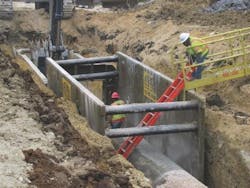Trench work is inherently dangerous, and trench boxes used in trench and excavation projects help keep workers safe and protected from cave-ins.
Eight tips from United Rentals enhance trench box safety to help contractors promote safe work practices in trenching and excavation operations:
1) Don’t count on a trench box to prevent a cave-in: A trench box is a protective system designed to keep workers safe, not an active shoring designed to keep trench walls from collapsing. If a trench worksite needs both worker protection and active shoring, contractors should make a system that applies a load to the trench wall greater than the earthen load coming from the trench wall.
2) Follow the manufacturer’s tabulated data: It is essential to use a trench box within its tabulated data. One common problem is using a trench box at a depth greater than the maximum depth it is rated for. The manufacturer’s tabulated data will help instruct the contractor on the allowable configuration.
3) Watch the bottom: There have been worksites where contractors place a box three feet off the bottom of a trench instead of the maximum of two feet that OSHA regulations allow. If the box is more than two feet off the bottom, there is a risk of a cave-in from below.
4) Watch the top: If a contractor is using sloping in combination with a trench box, typically, the top of the trench box must be at least 18 inches above the point where the soil intersects the shield. Those 18 inches serve as a roll-off protection.
5) Replace any damaged spreader pipe or trench box panels: Often the spreader pipe can get bent or damaged, especially if an excavator lifts or moves the trench box using the spreader pipe instead of the actual lift points. If the shield exhibits deflection, it should be taken out for further inspection and possibly removed from service.
6) Install panels or plates in the right place: If a contractor is using trench shield panels as end panels, always follow the engineering guidelines that address end protection. Do not place the panels directly against the spreader pipes.
7) Stack with care: Make sure the stacking pockets are lined up and the boxes are pinned together so the boxes can be properly secured vertically. If there are different thicknesses of trench boxes–say 4 inch, 6 inch and 8 inch–the thinner trench boxes usually go on top.
8) Backfill the gap: By definition, a trench will always be wider than a trench shield placed within it. To eliminate the gap, backfill the void to stabilize the shield. Remember that the shield must always be situated so as to restrict lateral or other hazardous movement.





